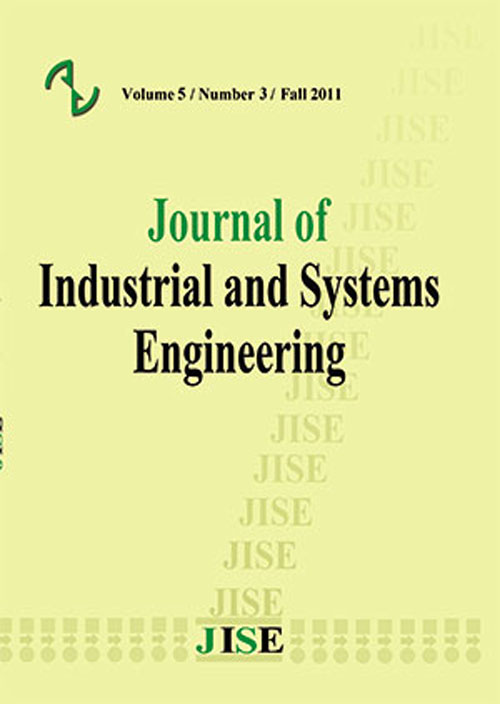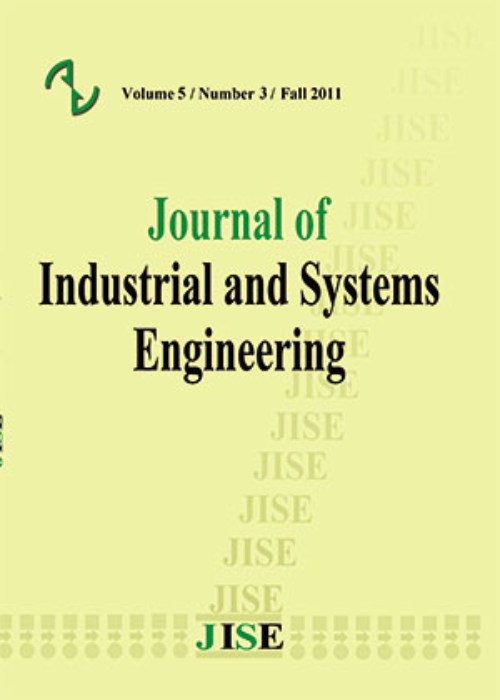فهرست مطالب

Journal of Industrial and Systems Engineering
Volume:13 Issue: 3, Summer 2021
- 17th International Industrial Engineering Conference
- تاریخ انتشار: 1400/06/07
- تعداد عناوین: 7
-
-
Pages 1-11Cellular manufacturing system (CMS) is one of the well-developed subjects in the manufacturing systems area due to its many advantages. This subject is categorized to four sub problem including cell formation, group layout, and group scheduling and resource assignment. Despite of the importance of facility layout in manufacturing productivity, layout design is less investigated compared to the other problems in CMS, especially while considering uncertain demand of the real world. Hence, ignoring this issue leads to inefficiency in the models. In this paper, a new mathematical modeling is proposed to design a robust facility layout in CMS in the presence of uncertainty. This model simultaneously minimizes the cost of inter-cell and intra-cell movements based on two robust approaches. In the first approach, the worst case scenario is minimized in absolute robustness criterion and deviation from the optimal solutions are minimized by the robust deviation in the second approach. Moreover, the integer nonlinear model is linearized in order to solve it by linear programing. Finally, the performance of the proposed model is evaluated through a numerical example.Keywords: Cellular manufacturing system (CMS), Facility layout problem, robust design, uncertain demand, inter-cell, intra-cell movement
-
Pages 12-20
In this paper, a bi-objective mixed-integer model for energy-aware production scheduling of continuous slurry ball mills is proposed. Slurry ball mills are considered as the main consumer of electrical energy and impose high energy costs on tile factories. Hence, minimizing the energy costs associated with slurry production through implementation of peak-load minimization strategy and optimal assignment of orders to ball mills is the main goal which is considered in this study. On the other hand, the quality of slurry has a significant effect on the quality of produced tiles. An increase in time which slurry has left in rotating slip tanks, i.e. stirring time, helps improve its quality. Thus, the second goal which is pursued in this scheduling is compliance with the stirring time standards. The effectiveness of the proposed model is illustrated on a small-scale case study with a saving of above 15% in energy costs.
Keywords: ceramic tile industry, slurry ball mills, Energy-aware scheduling, stirring time -
Pages 21-29
Vendor management inventory (VMI), as one of the inventory management methods, reduces the cost of inventory in the chain, quick response to customers, increased service level, customer satisfaction, and improve collaboration between the members of the supply chain. In this study, a bi-level supply chain model with one manufacturer and one retailer under a vendor management inventory policy is investigated. The manufacturer produces a single product by the production capacity constraint at wholesale price and delivers the product to the retailer who then sells the product in the dispread market at retail price. The demand rate for the product in the retailer market is assumed to be a decreasing function of the price and an increasing function of the service level. The manufacturer determines its wholesale price, product’s replenishment cycle time, and backorder quantity to maximize its profit. Retailer determines the optimal retail price and service level to maximize its profit. This problem formulated as a Stackelberg game model with consideration manufacture as a leader and retailer as a follower. To search the Stackelberg game equilibrium, a solution algorithm has been proposed. A numerical study has been conducted to demonstrate how the algorithm works and to understand the influences of decision variables and parameters. Also, in order to validate the proposed model, sensitivity analysis has been performed on some parameters.
Keywords: Supply chain management, Vendor Managed Inventory (VMI), Stackelberg game, price, Service level -
Pages 30-36In this study, supply chain network design is considered. Responsibility and profitability are the company's main features, so we proposed a model to maximize profit, reducing logistic costs, especially shortage costs, to increase responsibility. Adopting the right sales policy by a seller is an issue that needs to be addressed. In this research, we try to improve sales conditions based on each channel's capacity by considering the all unit discount policy for each channel's sale. We used a price-dependent demand function to bring the situation closer to the real world. We considered the factor of advertising and inflation on demand in this issue. A mixed-integer nonlinear programming model is introduced for the problem and formulated in GAMS software; then, sensitivity analysis examines some parameters.Keywords: Supply chain network design, discount policy, price-depended demand function, logistic cost, Multi-Channel, Multi-Product
-
Pages 37-54The first case of the unknown coronavirus, referred to as COVID-19, was detected in Wuhan, China, in late December 2019, and spread throughout China and globally. The total confirmed cases globally are rising day by day. This study proposes a novel prediction model to estimate and predict the total confirmed cases of COVID-19 in the next two days, according to Iran’s confirmed cases reported before. The proposed model is an improved adaptive neuro-fuzzy inference system (ANFIS) using a co-evolutionary PSO-GA algorithm. PSO-GA is generally used to strike a balance between exploration and exploitation capabilities enhanced further by integrating the genetic operators, i.e., mutation and crossover in the PSO algorithm. The proposed model (i.e., PSO-GA-ANFIS) thus aims to enhance the efficiency of the ANFIS model by determining ANFIS parameters using PSO-GA. The model is assessed by utilizing epidemiological data provided by John Hopkins University to forecast the COVID-19 epidemic prevalence trend of Iran in 02.20.2020-06.10.2020-time window. A comparison was also made between the proposed model and a couple of available models. The results indicated that the proposed model outperforms the other models regarding MSE, RMSE, MAPE, and R2.Keywords: ANFIS, PSO-GA, COVID-19, Prediction Model, time series
-
Pages 55-62This study considers an online multi-period assortment optimization problem over multiple replenishment cycles where the seller chooses a subset from N substitutable products and decides the limited amount of each to order and sell at every period. The seller is constrained by a total inventory capacity, a cardinality constraint on the product variety (shelf space), and predetermined replenishment time intervals. The assortment selection is modeled as a Multi-armed bandit problem and the customers' choice is modeled by the MNL choice model. The objective is to optimize the revenue by learning the demand parameters and improve the offering composition at every period. In this novel approach, the offering and consequently the exploration-exploitation decision has two dimensions: the assortment and the inventory allocation. The present research develops a model and policy for learning and optimization that demonstrates good performance in numerical simulations. The results suggest that capacity constraint has a significant impact on the total profit of a seller who tries to learn the demand and the best inventory composition on the fly.Keywords: Multi-Armed Bandit (MAB), Thompson Sampling, multinomial logit choice model, computational modeling, simulation
-
Pages 63-69
Infrastructure development is one of the key aspects to be prioritized if economic growth is to be maintained in developing countries. Amongst the bottlenecks in this path which impede the construction and expansion of the infrastructure facilities, lack of public funding is one of the primary issues. To tackle such a problem, governments are launching public-private partnership frameworks to raise funds for these projects. Studies on various methods of public-private partnerships suggest BOT (build, operate, transfer) as one of the most common and most successful ways of participation for the private sector in public projects and establishing a framework for the management of project risks. This project aims to provide a framework by which projects are prioritized according to their social welfare factors in the first step. Second step objective is to minimize the risks of taxes, utilization period, project lifetime, and highway capacity by solving a multi objective mathematical model. This is all done by proposing a two-stage optimization model based on reservation level Driven Tchebycheff Procedure (RLTP) and differential evolution (DE) algorithm to evaluate projects and prioritizing them based on their defined factors and associated risks. The model ensures that the private sector benefits from the execution and operation of the project in the BOT framework and the expected social welfare is also guaranteed. As a case study, data of the projects in transportation and road construction sector is obtained and evaluated.
Keywords: Differential evolution algorithm, Reservation Level Driven Tchebycheff Procedure (RLTP), Project selection, road construction risks


